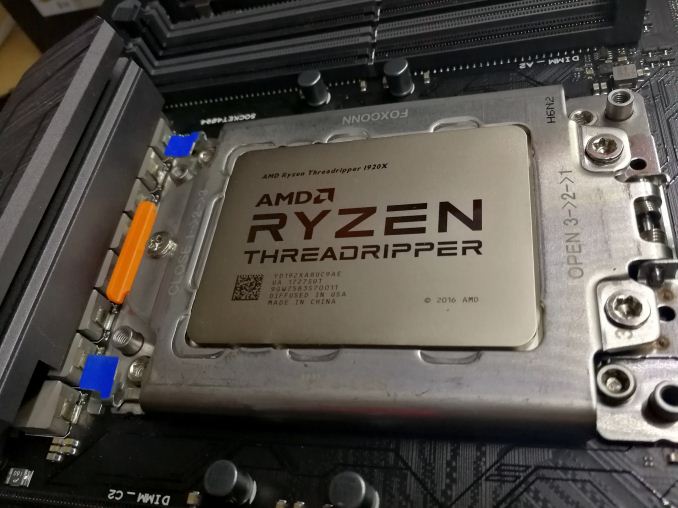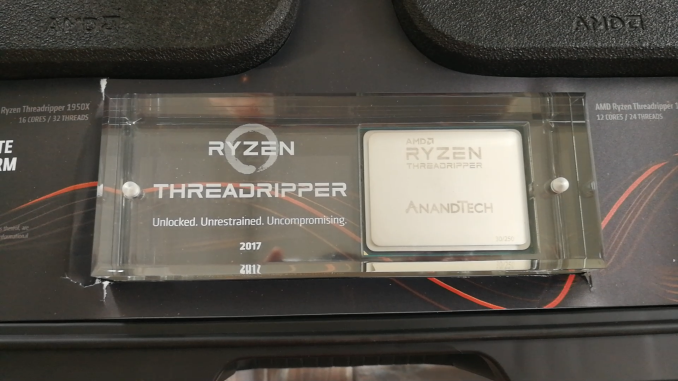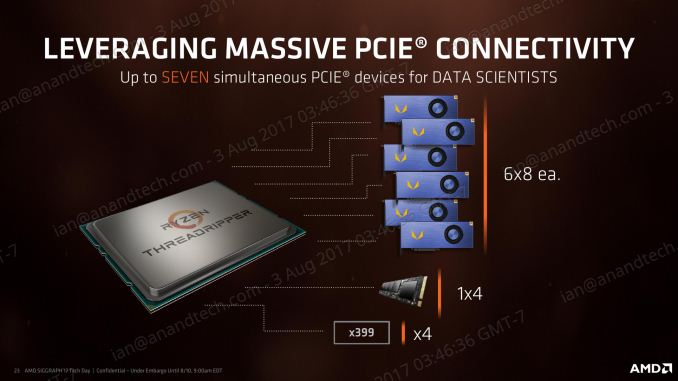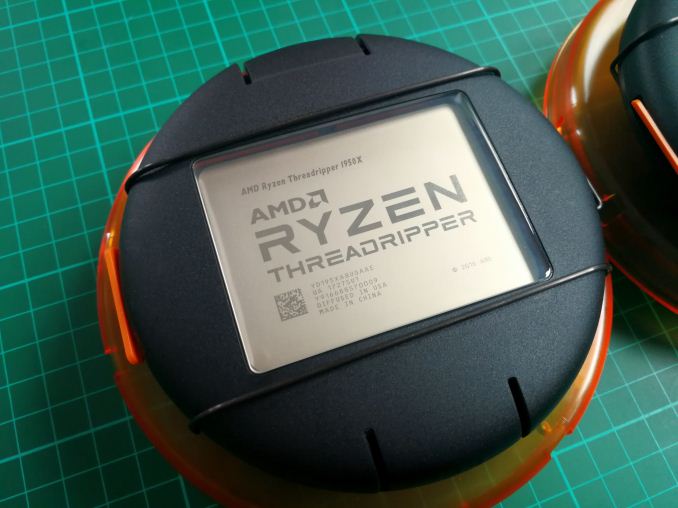The AMD Ryzen Threadripper 1950X and 1920X Review: CPUs on Steroids
by Ian Cutress on August 10, 2017 9:00 AM ESTFinal Thoughts: Do or Do Not - There is no Try
In this review we’ve covered several important topics surrounding CPUs with large numbers of cores: power, frequency, and the need to feed the beast. Running a CPU is like the inverse of a diet – you need to put all the data in to get any data out. The more pi that can be fed in, the better the utilization of what you have under the hood.
AMD and Intel take different approaches to this. We have a multi-die solution compared to a monolithic solution. We have core complexes and Infinity Fabric compared to a MoDe-X based mesh. We have unified memory access compared to non-uniform memory access. Both are going hard against frequency and both are battling against power consumption. AMD supports ECC and more PCIe lanes, while Intel provides a more complete chipset and specialist AVX-512 instructions. Both are competing in the high-end prosumer and workstation markets, promoting high-throughput multi-tasking scenarios as the key to unlocking the potential of their processors.
| The Battle | |||||||||
| Cores/ Threads |
Base/ Turbo |
XFR/ TB |
L3 | DRAM 1DPC |
PCIe | TDP | Cost (8/10) |
||
| AMD | TR 1950X | 16/32 | 3.4/4.0 | +200 | 32 MB | 4x2666 | 60 | 180W | $999 |
| Intel | i9-7900X | 10/20 | 3.3/4.3 | +200 | 13.75 | 4x2666 | 44 | 140W | $980 |
| Intel | i7-6950X | 10/20 | 3.0/3.5 | +500 | 25 MB | 4x2400 | 40 | 140W | $1499 |
| AMD | TR 1920X | 12/24 | 3.5/4.0 | +200 | 32 MB | 4x2666 | 60 | 180W | $799 |
| Intel | i7-7820X | 8/16 | 3.6/4.3 | +200 | 11 MB | 4x2666 | 28 | 140W | $593 |
What most users will see on the specification sheet is this: compared to the Core i9-7900X, the AMD Ryzen Threadripper 1950X has 6 more cores, 16 more PCIe lanes, and ECC support for the same price. Compared to the upcoming sixteen core Core i9-7960X, the Threadripper 1950X still has 16 more PCIe lanes, ECC support, but is now substantially cheaper.
On the side of the 1920X, users will again see more cores, ECC support, and over double the number of PCIe lanes compared to the Core i7-7820X for $100 difference. Simply put, if there is hardware that need PCIe lanes, AMD has the solution.
In our performance benchmarks, there are multiple angles to describe the results we have collected. AMD is still behind when it comes to raw IPC, but plays competitively in frequency. Intel still wins the single threaded tasks, especially those that rely on DRAM latency. AMD pulls ahead when anything needs serious threads by a large amount, and most of the time the memory arrangement is not as much of an Achilles heel as might be portrayed. If a user has a workload that scales, AMD is bringing the cores to help it scale as wide as possible.
Despite Threadripper's design arguably being better tuned to highly threaded workstation-like workloads, the fact that it still has high clocks compared to Ryzen 7 means that gaming is going to be a big part of the equation too. In its default Creative Mode, Threadripper’s gaming performance is middling at best: very few games can use all those threads and the variable DRAM latency means that the cores are sometimes metaphorically tripping over themselves trying to talk to each other and predict when work will be done. To solve this, AMD is offering Game Mode, which cuts the number of cores and focuses memory allocations to the DRAM nearest to the core (at the expense of peak DRAM bandwidth). This has the biggest effect on minimum frame rates rather than average frame rates, and affects 1080p more than 4K, which is perhaps the opposite end of the spectrum to what a top-level enthusiast would be gaming on. In some games, Game Mode makes no difference, while in others it can open up new possibilities. We have a full article on Game Mode here.
If I were to turn around and say that Threadripper CPUs were not pure gaming CPUs, it would annoy a fair lick of the tech audience. The data is there – it’s not the best gaming CPU. But AMD would spin it like this: it allows the user to game, to stream, to watch and to process all at the same time.
You need a lot to do in order to fill 16 cores to the max, and for those that do, it’s a potential winner. For anyone that needs hardcore throughput such as transcode, decode, rendering such as Blender, Cinema 4D or ray-tracing, it’s a great CPU to have. For multi-GPUs or multi-storage aficionados or the part of the crowd that wants to cram a bunch of six PCIe 3.0 x8 FPGAs into a system, AMD has you covered.
Otherwise, as awesome as having 16 cores in a consumer processor is – and for that matter as awesome as the whole Threadripper name is in a 90s hardcore technology kind of way – Threadripper's threads are something of a mixed blessing in consumer workloads. A few well-known workloads can fully saturate the chip – video encoding being the best example – and a number of others can't meaningfully get above a few threads. Some of this has been due to the fact that for the last 8 years, the bread-and-butter of high-end consumer processors have been Intel's quad-core chips. But more than that, pesky Amdahl's Law is never too far away as core counts increase.
The wildcard factor here – and perhaps the area where AMD is treading the most new ground – is in the non-uniform allocation of the cores. NUMA has never been a consumer concern until now, so AMD gets to face the teething issues of that introduction head on. Having multiple modes is a very smart choice, especially since there's a good bit of software out there that isn't fully NUMA-aware, but can fill the CPU if NUMA is taken out of the equation and the CPU is treated as a truly monolithic device. Less enjoyable however is the fact that switching modes requires a reboot; you can have your cake and eat it too thanks to mode switching, but it's a very high friction activity. In the long-term, NUMA-aware code would negate the need for local vs distributed if the code would pin to the lowest latency memory automatically. But in lieu of that, AMD has created the next best thing, as even in an ideal world NUMA is not without its programming challenges, and consequently it's unlikely that every program in the future will pin its own memory correctly.
In that respect, a NUMA-style CPU is currently a bit of a liability in the consumer space, as it's very good for certain extreme workloads but not as well balanced as a single Ryzen. Costs aside, this means that Threadripper isn't always a meaningful performance upgrade over Ryzen. And this isn't a catch unique to AMD – for the longest time, Intel's HEDT products have required choosing between core counts and top-tier single-threaded performance – but the product calculus has become even more complex with Threadripper. There are trade-offs to scaling a CPU to so many cores, and Threadripper bears those costs. So for the consumer market its primarily aimed at, it's more important than ever to consider your planned workloads. Do you need faster Handbrake encoding or smoother gameplay? Can you throw enough cores at Threadripper to keep the beast occupied, or do you only occasionally need more than Ryzen 7's existing 8 cores?
AMD has promised that the socket will live for at least two generations, so Threadripper 2000-series when it comes along should drop straight in after a BIOS update. What makes it interesting is that with the size of the socket and the silicon configuration, AMD could easily make those two ‘dead’ silicon packages into ‘real’ silicon packages, and offer 32 cores. (Although those extra cores would always be polling at far memory speeds).
This is the Core Wars. A point goes to the first chip that calculate the Kessel run in under twelve parsecs.














347 Comments
View All Comments
nitin213 - Thursday, August 10, 2017 - link
Thanks for your reply. Hopefully the test suite can be expanded as Intel's CPUs probably also move to higher core count and IO ranges in future.and i completely understand the frustration trying to get a 3rd party to change their defaults. Cheers
deathBOB - Thursday, August 10, 2017 - link
It's clear to me . . . Ian is playing both sides and making out like a bandit! /sFreckledTrout - Thursday, August 10, 2017 - link
Ian can we get an updated comments section so we can +/- people and after x number of minuses they wont show by default. I'm saying this because some of these comments(the one in this chain included) are not meaningful responces. The comments section is by far the weakest link on Anantech.Nice review btw.
mapesdhs - Thursday, August 10, 2017 - link
toms has that, indeed it's kinda handy for blanking out the trolls. Whether it's any useful indicator of "valid" opinion though, well, that kinda varies. :D (there's nowt to stop the trolls from voting everything under the sun, though one option would be to auto-suspend someone's ability to vote if their own posts get hidden from down voting too often, a hands-off way of slapping the trolls)Given the choice, I'd much rather just be able to *edit* what I've posted than up/down-vote what others have written. I still smile recalling a guy who posted a followup to apologise for the typos in his o.p., but the followup had typos aswell, after which he posted aaaaagh. :D
Ian.
Johan Steyn - Thursday, August 10, 2017 - link
Ian thanks for at least responding, I appreciate it. Please compare your review to sites like PCPer and many others. They have no problem to also point out the weak points of TR, yet clearly understand for what TR was mostly designed and focus properly on it and even though they did not test the 64 PCI lanes as an example, mention that they are planning a follow-up to do it, since it is an important point. You do mention these as well, but could have said more than just mention it by the way.Look at your review, most of it is about games. Are you serious?
I have to give you credit to at least mention the problems with Sysmark.
Let me give you an example of slanted journalism, When you do the rendering benchmarks, where AMD is known to shine, you only mention at each benchmark what they do etc, and fail to mention that AMD clearly beats Intel, even though other sites focus more ons these benchmarks. In the one benchmark where Intel get a descent score, you take time to mention that:
"Though it's interesting just how close the 10-core Core i9-7900X gets in the CPU (C++) test despite a significant core count disadvantage, likely due to a combination of higher IPC and clockspeeds."
Not in one of the rendering benchmarks do you give credit to AMD, yet you found it fitting to end the section of with:
"Intel recently announced that its new 18-core chip scores 3200 on Cinebench R15. That would be an extra 6.7% performance over the Threadripper 1950X for 2x the cost."
Not slanted journalism? At least you mention "2x the cost," but for most this will not defer them in buying the monopoly.
After focussing so much time on game performance, I am not sure you understand TR at all. AMD still has a long way to go in many areas. Why? Because corrupt Intel basically drove them to bankruptcy, but that is a discussion for another day. I lived through those days and experienced it myself.
Maybe I missed it, but where did you discuss the issue of memory speed? You mention in the beginning of memory overclock. Did you test the system running at 3200 or 2666? It is important to note. If you ran at 2666, then you are missing a very important point. Ryzen is known to gain a huge amount with memory speed. You should not regard 3200 as an overclock, since that is what that memory is made for, even if 2666 is standard spec. Most other sites I checked, used it like that. If you did use 3200, don't you think you should mention it?
Why is it that your review ends up meh about TR and leave you rather wanting an i9 an almost all respects, yet most of the other site gives admiration where deserved, even though they have criticism as well. Ian I see that you clearly are disappointed with TR, which is OK, maybe you just like playing games and that is why you are so.
It was clear how much you admire Intel in your previous article. You say that I gave no examples of slanted journalism, maybe you should read my post again. "Most Powerful, Most scalable." It is well known that people don't read the fine print. This was intentional. If not, you are a very unlucky guys for having so many unintended mishaps. Then I truly need to say I am sorry.
For once, please be a bit excited that there is some competition against the monopoly of Intel, or maybe you are also deluded that they became so without any underhanded ways.
By the way, sorry that I called you Anand. I actually wanted to type Anandtech, but left it like it. This site still carries his name and he should still take responsibility. After I posted, I realised I should have just checked the author, so sorry about that.
vanilla_gorilla - Thursday, August 10, 2017 - link
"Intel recently announced that its new 18-core chip scores 3200 on Cinebench R15. That would be an extra 6.7% performance over the Threadripper 1950X for 2x the cost."How do you not understand that is a dig at Intel? He's saying you have to pay twice as much for only a 6.7% improvement.
smilingcrow - Thursday, August 10, 2017 - link
The memory speed approach taken was clearly explained in the test and was stated as being consistent with how they always test.I don't take issue with testing at stock speeds at launch day as running memory out of spec for the system can be evaluated in depth later on.
Johan Steyn - Friday, August 11, 2017 - link
That is just rubbish. Threadripper has no problem with 3200 memory and other sites has no problem running it at that speed. 3200 memory is designed to run 3200, why run it at 2666? There is just no excuse except being paid by Intel.Maybe then you can accuse other sites of being unscientific?
fanofanand - Tuesday, August 15, 2017 - link
Anandtech always tests at JDEC, regardless of the brand.Manch - Friday, August 11, 2017 - link
""Intel recently announced that its new 18-core chip scores 3200 on Cinebench R15. That would be an extra 6.7% performance over the Threadripper 1950X for 2x the cost."Not slanted journalism? At least you mention "2x the cost," but for most this will not defer them in buying the monopoly."
You call Intel the monopoly and call him out for not wording the sentence to dissuade people from buying Intel. Who has the bias here? If he was actively promoting Intel over AMD or vice versa, you'd be OK with the latter, but to do neither. He's an Intel shill? Come on. That's unfair. HOW should he have wrote it so it would satisfy you?
FYI Anand is gone. He's NOT responsible for anything at Anandtech. Are you going to hold Wozniak's feet to the fire for the lack of ports on a Mac too?